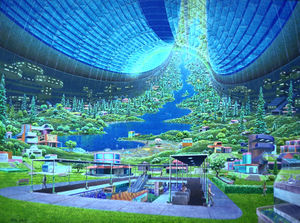Difference between revisions of "Stanford torus"
m (→Stanford tori and other Rings in Fenspace) |
m (fixed broken external link) |
||
| Line 3: | Line 3: | ||
[[Image:Toroid.jpg|thumb|right|The classic Stanford torus]] | [[Image:Toroid.jpg|thumb|right|The classic Stanford torus]] | ||
| − | The '''Stanford torus''' is a design proposed during the 1975 [[NASA]] Summer Study<ref>National Aeronautics and Space Administration, ''[http:// | + | The '''Stanford torus''' is a design proposed during the 1975 [[NASA]] Summer Study<ref>National Aeronautics and Space Administration, ''[http://settlement.arc.nasa.gov/75SummerStudy/Table_of_Contents1.html Space Settlements: A Design Study]'', 1977</ref> for a space habitat capable of housing 10,000 to 140,000 permanent residents. |
Technically, "Stanford torus" refers only to the version of the design proposed during the 1975 NASA Summer Study conducted at Stanford University; the concept of a ring-shaped rotating space station had previously been proposed by Wernher von Braun<ref>Von Braun, W., ''Crossing the Final Frontier,'' Colliers, March 22, 1952</ref> and Herman Potočnik.<ref>Herman Potočnik, ''The Problem of Space Travel'', 1929</ref> However, Fen are often more loose with their terminology, and some refer to any ring station as a "torus", a "Stanford torus", or a "2001 torus". | Technically, "Stanford torus" refers only to the version of the design proposed during the 1975 NASA Summer Study conducted at Stanford University; the concept of a ring-shaped rotating space station had previously been proposed by Wernher von Braun<ref>Von Braun, W., ''Crossing the Final Frontier,'' Colliers, March 22, 1952</ref> and Herman Potočnik.<ref>Herman Potočnik, ''The Problem of Space Travel'', 1929</ref> However, Fen are often more loose with their terminology, and some refer to any ring station as a "torus", a "Stanford torus", or a "2001 torus". | ||
Latest revision as of 14:18, 18 December 2015
| This page is written or contains material written in the metafictional (or OOC) voice. This material may contain spoilers, Easter Eggs, or other data not generally known in the world of Fenspace. The reader is duly warned. -The Mgt. |
The Stanford torus is a design proposed during the 1975 NASA Summer Study[1] for a space habitat capable of housing 10,000 to 140,000 permanent residents.
Technically, "Stanford torus" refers only to the version of the design proposed during the 1975 NASA Summer Study conducted at Stanford University; the concept of a ring-shaped rotating space station had previously been proposed by Wernher von Braun[2] and Herman Potočnik.[3] However, Fen are often more loose with their terminology, and some refer to any ring station as a "torus", a "Stanford torus", or a "2001 torus".
The proposed 10,000-person habitat described in the 1975 Summer Study is a torus (donut-shaped ring) 1.8 km in diameter, and rotates once per minute to provide between 0.9g and 1.0g of artificial gravity on the inside of the outer ring via centrifugal force. Stanford tori in Fenspace do not rotate that quickly[4] (or, in some cases, at all); instead, they use the same artificial gravity systems used by Fen spacecraft to provide a steady 1g.
The ring is connected to a hub via a number of "spokes", which serve as conduits for people and materials traveling to and from the hub. Since the hub is at the rotational axis of the station, it is the easiest location for spacecraft to dock.
The interior space of the torus itself is used as living space, and is large enough that a "natural" environment can be simulated; the torus appears similar to a long, narrow, straight glacial valley whose ends curve upward and eventually meet overhead to form a complete circle. Sunlight is provided to the interior of the torus by a system of mirrors. The population density is similar to a dense suburb, with parts of the ring dedicated to agriculture and other parts to housing. Most of the Fen Stanford tori stations place their administration and industrial facilities in the station's hub, where the artificial gravity can be tailored to particular needs.
Gerard O'Neill later proposed his "Island One" or Bernal sphere as an alternative to the torus.
Stanford tori and other Rings in Fenspace
Of all the classic space station designs, the torus (Stanford and otherwise) is the most popular in Fenspace. They're more popular than a Bernal sphere because they're smaller, and thus cost less to build. Besides, the tourists who grew up with 2001: A Space Odyssey expect them, and the Convention likes to stay on friendly terms with the Earthbound nations.
Of the space stations that have been described so far, Arisia Station and Chawla are near-textbook Stanford tori, while Clarke County, McAuliffe, Odyssey, Over The Rainbow, Stellvia, and Ultima are modified ring structures (and Libertatia is a partial ring).
Notes
Real-world data on this page was sourced from Wikipedia and NASA.
- ↑ National Aeronautics and Space Administration, Space Settlements: A Design Study, 1977
- ↑ Von Braun, W., Crossing the Final Frontier, Colliers, March 22, 1952
- ↑ Herman Potočnik, The Problem of Space Travel, 1929
- ↑ Some people get upset when they discover their beds are traveling at over 200 miles per hour.

